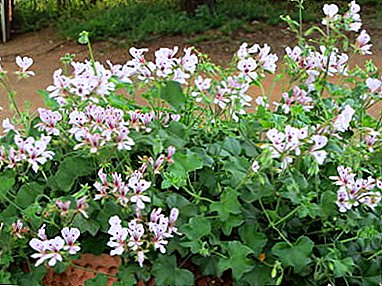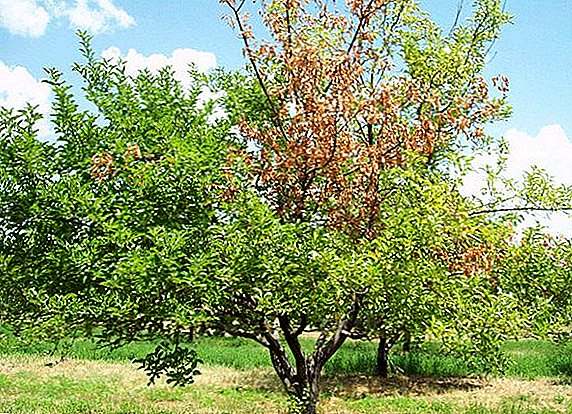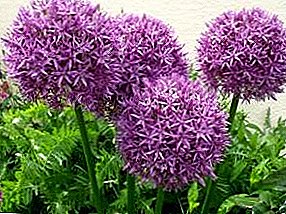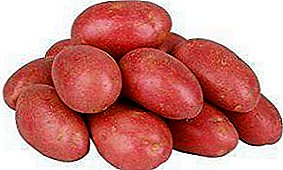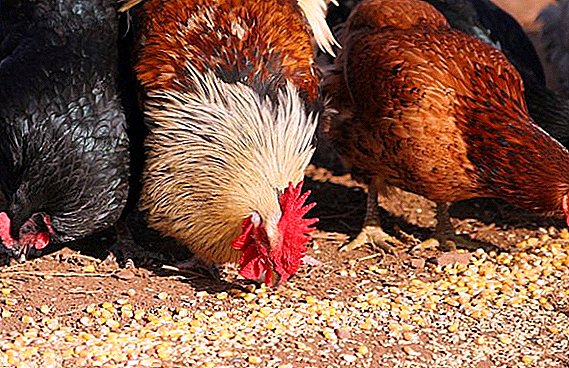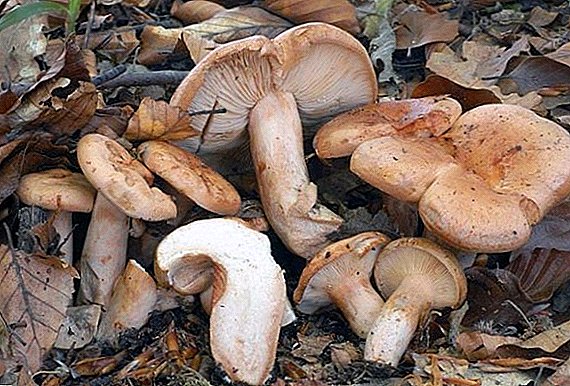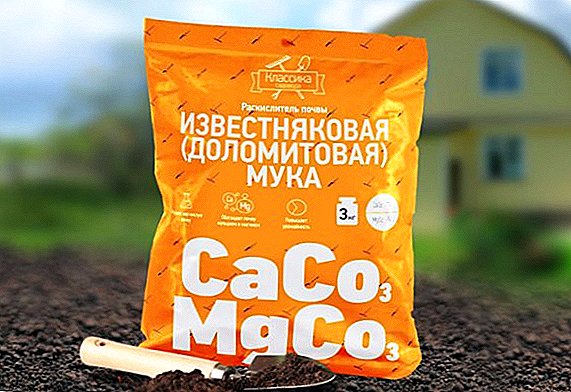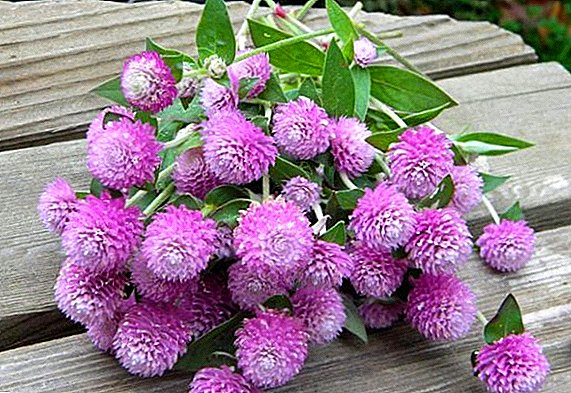 Each owner of the cottage or garden plots tends to decorate it with various compositions of greenery and flowers. Along with the standard green spaces and all the familiar roses and daisies, the guest of the plot is a gomfrena. The name of the flower is not familiar to many, but there is hardly a person who has not seen it in a flowerbed or in a bouquet of dried flowers. We find out what caused his popularity.
Each owner of the cottage or garden plots tends to decorate it with various compositions of greenery and flowers. Along with the standard green spaces and all the familiar roses and daisies, the guest of the plot is a gomfrena. The name of the flower is not familiar to many, but there is hardly a person who has not seen it in a flowerbed or in a bouquet of dried flowers. We find out what caused his popularity.
Botanical description
Gomfrena belongs to the amaranth family, is an annual or perennial plant, depending on the species.
The Amaranth family also includes such plants as spinach, irezine, chard, and white mary.
It is a collection of grasses with a straight, strongly branching stem, on which green petioled leaves are located oval-shaped. 
Bush height usually about 50 cm Flowers are located singly at the end of each individual shoot, outwardly they resemble clover flowers: spherical, consisting of small petals. Head diameter - about 4 cm, the flower has 5 stamens.
Bud color may vary depending on the variety, ranging from purple and red to white and yellow. Fetus - seed.
Flowering period It begins in summer, in the beginning of July, and lasts until the first night frosts appear.
Distribution and habitat
Tropics, especially South America, are considered the birthplace of the flower;
Did you know? In the countries of East Asia, the flower is used not only for decorative purposes, but also eaten and used in medicine.

Types
The relative of amaranth has about 90 species. Of course, in our latitudes they are found in a very limited quantity due to climatic features, therefore, we consider the most popular ones.
- Gomphrena globosa, or globose. This is the most common type of culture, the classic representative of the family, its characteristics are described above.

- Scattered gomfrena so called because its stems have a special creep and are able to grow powerfully in width. Good for growing in pots, from which the stems will hang down. It has elongated leaves and motley small flowers.

- Golden-flowered, or hage. This is a Mexican variety of a flower, the bush is usually small, up to 30 cm. It is characterized by large bright red buds and a lower flowering intensity compared with Gomphrena globosa. The plant of this species is very demanding to heat, so in our area it blooms only in summer.

- Dwarf, or gomfrena "Dwarf". It got its name because of its small size - the height of the stems does not exceed 15 cm. It blooms with spherical inflorescences located on short legs, so the flower can often be found as a frame for the borders of garden paths.

- Purple - is a plant with stems of medium length, about 30 cm, with flowers in the form of balls of saturated purple tone. Leaves are dark green, large. When growing, it visually resembles a carpet dotted with red berries.

Did you know? Homfren and other dried flowers in the 19th century were called "immortal", which means "immortal", because in a dried bouquet they can maintain a natural look for up to 3 years.
Use in landscape design
The variety of varieties allows the use of homophrenic in almost any flower arrangement, and not only in the conditions of a home garden, but also in urban flower beds and parks.
- Low-growing varieties of plants will be an excellent decoration for rock gardens, giving them a natural look. In combination with asters such species emphasize the geometry of rabatok and other beds. The unique ability to grow in a thick blanket makes gomfren ideal for landscaping curbs around paths.
- Flower species with tall stems are perfectly combined with other bushes in rock arias. Mixborders and ordinary flower gardens also benefit from the presence of gomfreny due to its long flowering and preservation of the appearance even with the onset of autumn.
- Void between the compositions in landscape design perfectly fill creeping scattered or dwarf homfrena.

The uniqueness of the plant lies in the fact that it not only perfectly adorns the garden beds, but also looks great in pots in the home interior.
Growing and caring for plants
Cultivation of homophrenic is a standard and not very complicated process. The flower is unpretentious, although it has certain features in the care.
Conditions of detention
Since the plant is home to the tropics, it is extremely thermophilic. To grow a flower you need to choose a warm place, well protected from the wind and drafts, always on the sunny side of the site.
Soil and fertilizer
Gomfrena likes light, loose, not rich soil of neutral acidity, which must be well drained. Suitable mixed soil of turf, sand, peat. Feed is needed twice: the first time - in the process of growing seedlings, the second - after planting in open ground. 
Important! Do not abuse fertilizers, because their excess can cause a weakening or even cessation of flowering.
Watering and moisture
Culture does not like excessive moisture, it is quite drought-resistant and excess watering can only harm. In hot weather, the plant should be watered moderately, but regularly as the soil dries. In the cool time with the beginning of autumn, you can stop watering - the flower will have enough natural moisture.
Relation to temperature
Gomfrena loves heat very much, so it’s quite difficult to survive in the middle lane. The most favorable time for a plant is from June to the beginning of autumn. But low temperatures can be disastrous for a delicate flower.
Even winter perennials are poorly tolerated by cold weather.
Such perennial flowers also include such plants as lupine, adonis, lunik, anhuza, heliopsis, September asters, and nemesia.
Due to the high sensitivity to frost, it is recommended to repot the bushes in flowerpots and clean the premises until spring. 
If this is not possible, it is necessary to cut off dried stems and flowers, protect the roots with dry leaves or straw and cover with a greenhouse film before the end of the cold weather.
Breeding
Plant reproduction is possible only by seeds from which the seedlings are grown, intended for planting. Sowing seeds in closed ground is produced in early spring (the period from March to April). 
- The first stage is to prepare the soil for sowing. The mixture should be loose and light with sand. It is important to remember that in order to disinfect a substrate, it is necessary to sterilize it with boiling water.
- The mixture is placed in a pre-prepared container: a tray or container. Seeds are placed on the soil at a short distance from each other - you do not need to bury them too deeply, it is enough to lightly press down with your finger.
- A tare with sowing, covered with a greenhouse film, is installed in a room with good lighting, where a constant temperature of + 21 ... +22 ° С is maintained.
- The first shoots will appear in about 2 weeks, at this point you can remove the insulation from the container and slightly shade the room.
- As soon as the number of shoots has increased (usually it happens closer to the 3rd week), it is necessary to carry out a picking, that is, plant the homphrene from the total capacity into separate pots or a larger total container. At this stage, the plant is first fertilized with mineral fertilizer for flowers.
To mineral fertilizers include such as "Kemira", "Plantafol", "Master", "Sudarushka", "Ammophos".
- When the weather is warm (May-June), it is time to transplant seedlings into open ground at the site. To do this, dig up the soil and loosen.
- In the substrate, small depths are dug out in increments of about 30 cm. For dwarf bushes, you can halve the distance to 15 cm. Sprouts are planted in the wells, after which the root is covered with earth, compacted and watered with moderate amount of water.
- During the first month of adaptation in open ground, the plant must be fed once with complex mineral fertilizer.

Important! In no case can not feed gomfrenu organic fertilizers, including manure, it can harm her.
Possible difficulties in growing
In general, homophrenic is very unpretentious in care, it does not require a specific approach, but there are nuances that can lead to negative consequences:
- The weakening or cessation of flowering. This is usually associated with an oversupply of nutrients and fertilizers in the soil.
- Poor germination of seeds.
- Excessive sensitivity to cold. Even a short-term cooling spell can destroy the plant.
- Sensitivity to watering. Despite drought tolerance, homphrenum does not tolerate long-term lack of moisture in extreme heat and suffers equally with excessive watering.

Diseases, pests and prevention
Oddly enough, a fragile flower is practically not susceptible to diseases and is rarely affected by pests, which is its uniqueness.
However, there are still several threatening factors that need to be considered:
- Aphid invasion. This parasite is able to destroy all the vegetation in the country, including homfren. Therefore, in order to prevent the appearance of aphids, it is necessary to treat the bushes with a special insecticide product of industrial production.
- Fungus root system. Such a disease can affect any plant, and especially sensitive to moisture homophrenic. To avoid root decay, it is necessary to observe a strict irrigation regime and loosen the soil well after it.

So, homophrenic spherical - bright plant, completely unpretentious in the care. She is able to bloom for a long time and very beautifully both at home and in the open field. It is enough to give the flower quite a bit of attention, and it will long delight you with its appearance.


